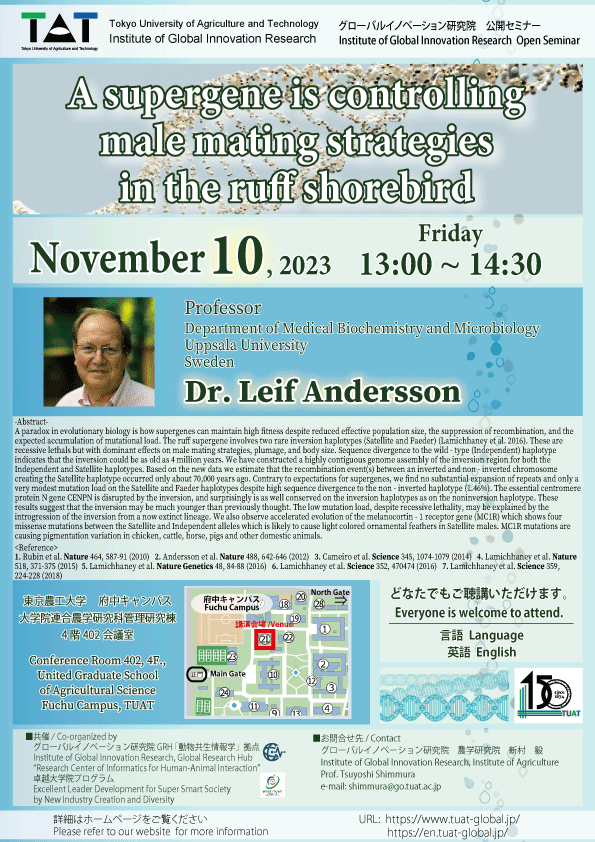イベント情報
【GIR公開セミナー】Dr. Leif Andersson / ウプサラ大学(スウェーデン)

| 日時 | 2023.11.10(13:00~14:30) |
|---|---|
| 会場 | |
| Google Classroom コード | 3wnnob5 |
| 講演者 | Dr. Leif Andersson |
| 所属機関 | ウプサラ大学 (スウェーデン) |
| 講演タイトル | "A supergene is controlling male mating strategies in the ruff shorebird" <要旨> A paradox in evolutionary biology is how supergenes can maintain high fitness despite reduced effective population size, the suppression of recombination, and the expected accumulation of mutational load. The ruff supergene involves two rare inversion haplotypes (Satellite and Faeder) (Lamichhaney et al. 2016). These are recessive lethals but with dominant effects on male mating strategies, plumage, and body size. Sequence divergence to the wild‐type (Independent) haplotype indicates that the inversion could be as old as 4 million years. We have constructed a highly contiguous genome assembly of the inversion region for both the Independent and Satellite haplotypes. Based on the new data we estimate that the recombination event(s) between an inverted and non‐inverted chromosome creating the Satellite haplotype occurred only about 70,000 years ago. Contrary to expectations for supergenes, we find no substantial expansion of repeats and only a very modest mutation load on the Satellite and Faeder haplotypes despite high sequence divergence to the non‐inverted haplotype (1.46%). The essential centromere protein N gene CENPN is disrupted by the inversion, and surprisingly is as well conserved on the inversion haplotypes as on the noninversion haplotype. These results suggest that the inversion may be much younger than previously thought. The low mutation load, despite recessive lethality, may be explained by the introgression of the inversion from a now extinct lineage. We also observe accelerated evolution of the melanocortin‐1 receptor gene (MC1R) which shows four missense mutations between the Satellite and Independent alleles which is likely to cause light colored ornamental feathers in Satellite males. MC1R mutations are causing pigmentation variation in chicken, cattle, horse, pigs and other domestic animals. -Reference- 1. Rubin et al. Nature 464, 587-91 (2010) 2. Andersson et al. Nature 488, 642-646 (2012) 3. Cameiro et al. Science 345, 1074-1079 (2014) 4. Lamichhaney et al. Nature 518, 371-375 (2015) 5. Lamichhaney et al. Nature Genetics 48, 84-88 (2016) 6. Lamichhaney et al. Science 352, 470474 (2016) 7. Lamichhaney et al. Science 359, 224-228 (2018) |
| 言語 | 英語 |
| 対象 | どなたでも、ご参加いただけます。 |
| 共催 | グローバルイノベーション研究院 GRH「 動物共生情報学」拠点 卓越大学院プログラム |
| お問い合わせ窓口 | グローバルイノベーション研究院・農学研究院 新村 毅 e-mail: shimmura(ここに@ を入れてください)go.tuat.ac.jp |
| 備考 | 後日、Google Classroomでも公開いたします。 |
このページの上部へ